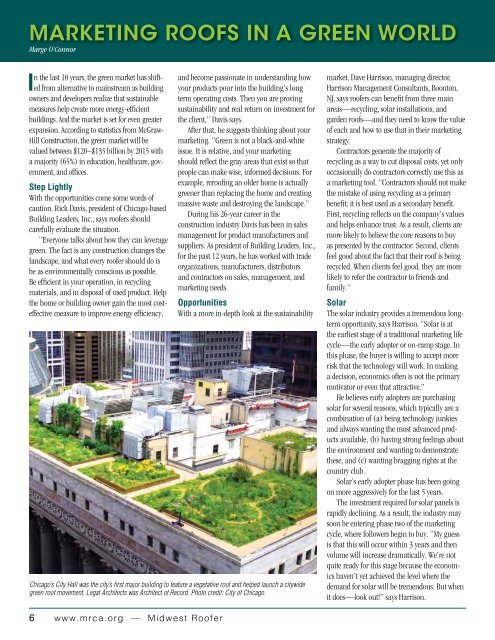The Relationship Still Rules! - Midwest Roofing Contractors ...
The Relationship Still Rules! - Midwest Roofing Contractors ...
The Relationship Still Rules! - Midwest Roofing Contractors ...
You also want an ePaper? Increase the reach of your titles
YUMPU automatically turns print PDFs into web optimized ePapers that Google loves.
marketing roofs in a green world<br />
Marge O’Connor<br />
In the last 10 years, the green market has shifted<br />
from alternative to mainstream as building<br />
owners and developers realize that sustainable<br />
measures help create more energy-efficient<br />
buildings. And the market is set for even greater<br />
expansion. According to statistics from McGraw-<br />
Hill Construction, the green market will be<br />
valued between $120–$135 billion by 2015 with<br />
a majority (65%) in education, healthcare, government,<br />
and offices.<br />
Step Lightly<br />
With the opportunities come some words of<br />
caution. Rick Davis, president of Chicago-based<br />
Building Leaders, Inc., says roofers should<br />
carefully evaluate the situation.<br />
“Everyone talks about how they can leverage<br />
green. <strong>The</strong> fact is any construction changes the<br />
landscape, and what every roofer should do is<br />
be as environmentally conscious as possible.<br />
Be efficient in your operation, in recycling<br />
materials, and in disposal of used product. Help<br />
the home or building owner gain the most costeffective<br />
measure to improve energy efficiency,<br />
6 www.mrca.org — <strong>Midwest</strong> Roofer<br />
and become passionate in understanding how<br />
your products pour into the building’s long<br />
term operating costs. <strong>The</strong>n you are proving<br />
sustainability and real return on investment for<br />
the client,” Davis says.<br />
After that, he suggests thinking about your<br />
marketing. “Green is not a black-and-white<br />
issue. It is relative, and your marketing<br />
should reflect the gray areas that exist so that<br />
people can make wise, informed decisions. For<br />
example, reroofing an older home is actually<br />
greener than replacing the home and creating<br />
massive waste and destroying the landscape.”<br />
During his 26-year career in the<br />
construction industry Davis has been in sales<br />
management for product manufacturers and<br />
suppliers. As president of Building Leaders, Inc.,<br />
for the past 12 years, he has worked with trade<br />
organizations, manufacturers, distributors<br />
and contractors on sales, management, and<br />
marketing needs.<br />
Opportunities<br />
With a more in-depth look at the sustainability<br />
Chicago’s City Hall was the city’s first major building to feature a vegetative roof and helped launch a citywide<br />
green roof movement. Legat Architects was Architect of Record. Photo credit: City of Chicago.<br />
market, Dave Harrison, managing director,<br />
Harrison Management Consultants, Boonton,<br />
NJ, says roofers can benefit from three main<br />
areas—recycling, solar installations, and<br />
garden roofs—and they need to know the value<br />
of each and how to use that in their marketing<br />
strategy.<br />
<strong>Contractors</strong> generate the majority of<br />
recycling as a way to cut disposal costs, yet only<br />
occasionally do contractors correctly use this as<br />
a marketing tool. “<strong>Contractors</strong> should not make<br />
the mistake of using recycling as a primary<br />
benefit; it is best used as a secondary benefit.<br />
First, recycling reflects on the company’s values<br />
and helps enhance trust. As a result, clients are<br />
more likely to believe the core reasons to buy<br />
as presented by the contractor. Second, clients<br />
feel good about the fact that their roof is being<br />
recycled. When clients feel good, they are more<br />
likely to refer the contractor to friends and<br />
family.”<br />
Solar<br />
<strong>The</strong> solar industry provides a tremendous longterm<br />
opportunity, says Harrison. “Solar is at<br />
the earliest stage of a traditional marketing life<br />
cycle—the early adopter or on-ramp stage. In<br />
this phase, the buyer is willing to accept more<br />
risk that the technology will work. In making<br />
a decision, economics often is not the primary<br />
motivator or even that attractive.”<br />
He believes early adopters are purchasing<br />
solar for several reasons, which typically are a<br />
combination of (a) being technology junkies<br />
and always wanting the most advanced products<br />
available, (b) having strong feelings about<br />
the environment and wanting to demonstrate<br />
these, and (c) wanting bragging rights at the<br />
country club.<br />
Solar’s early adopter phase has been going<br />
on more aggressively for the last 5 years.<br />
<strong>The</strong> investment required for solar panels is<br />
rapidly declining. As a result, the industry may<br />
soon be entering phase two of the marketing<br />
cycle, where followers begin to buy. “My guess<br />
is that this will occur within 3 years and then<br />
volume will increase dramatically. We’re not<br />
quite ready for this stage because the economics<br />
haven’t yet achieved the level where the<br />
demand for solar will be tremendous. But when<br />
it does—look out!” says Harrison.



